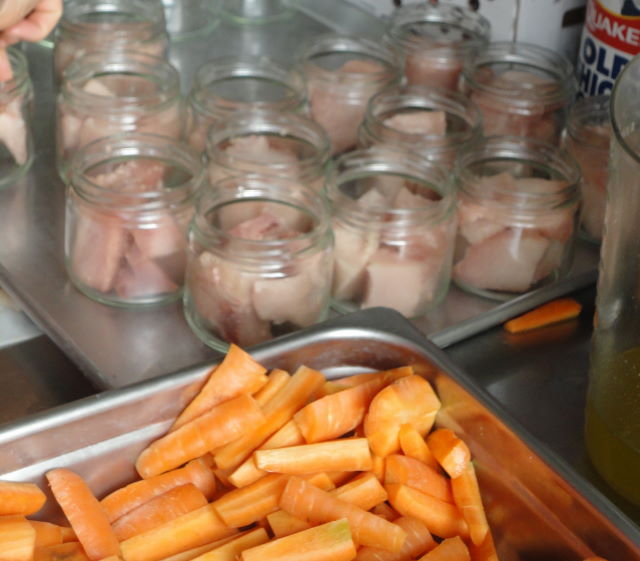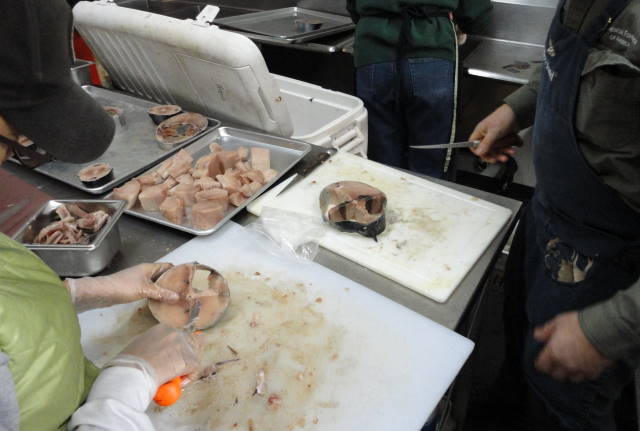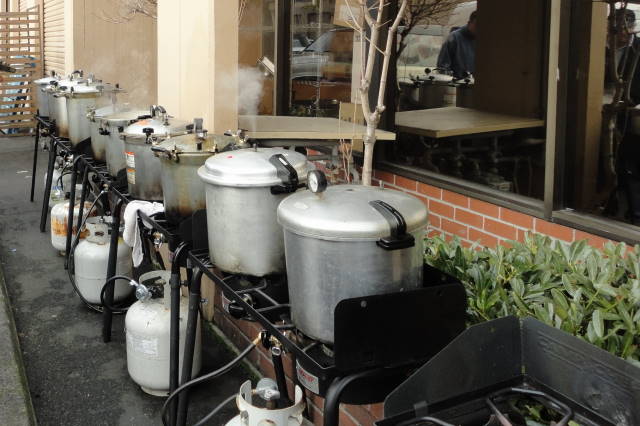
Slow Foods Seattle held their 2nd Annual Tuna Canning Workshop, directed by local fisherman Jeremy Brown on Sunday January 8, 2012. This event caught my eye for a couple of reasons.
First, I am a big fan of preserved fish in all of its many forms. Sardines, anchovies, octopus, tuna, herring, the whole world of those lesser known, stronger flavored fishes really shine when canned. Some are preserved using nothing but olive oil and a bit of salt, others are smoked or flavored with everything from tomatoes to chiles to herbs to, well just about everything. Canned fish is no substitute for fresh fish. It is not intended to be. Just as duck confit is a a wholly different food item than fresh duck but a fantastic one in its own right, preserving gives fish a whole new and delicious life.
Secondly, our house in Orthez is only about 50 minutes from Saint Jean de Luz, one of the most productive fishing ports in France, where the catch coming off the fishing boats every morning leans heavily toward tuna, sardines and anchovies among other species. As a result, the fishmongers in Orthez always offer an inspiring array of fishes that lend themselves to preserving. During the season, these fish are offered at prices that make putting down some preserves for the rest of the year a very attractive project. So the process for canning my own tuna seemed like valuable info that might well come in handy; I can envision a time when I will be canning tuna for myself every season, and maybe even teaching the technique to others as well.
Up to now, it seems preserved fish has been more appreciated in the rest of the world than here at home in the United States. Think of the pickled herring of Scandinavia, preserved sardines from Spain, tuna and anchovies from Italy, smoked fishes of every sort from Eastern Europe, tuna belly from France and you begin to get the idea. Preserved fish in these countries play a role in the archetypical dishes of the traditional cuisine. In all these places, canning has been seen for generations as not only a method of preserving the abundance of the sea beyond what can be eaten fresh, but as a process that yields a product to be admired for its for its own merits.
On the other hand, Americans (at least in my family) have tended to regard canned and preserved fish as a necessary evil when fresh is not available. My grandmother, whenever she ate salmon in Seattle, never failed to tell the story of how much she hated salmon growing up in Nebraska where the only salmon she ever say was from a can.
However, it is my observation that Americans are beginning to discover the pleasures of preserved fishes. When Le Pichet first opened, we had a hard time convincing people to try Spanish sardines and had to defend Italian tuna from charges that only fresh tuna is worthy of a good restaurant. Those days are gone, thank goodness and people are much more open to trying preserved fish. I love fresh sardines, tuna and anchovies in season, but I love a well made, artisan preserved fish just as much. Judging by the turnout at the Slow Food Tuna Canning Class, I am not the only one.

Fisherman Jeremy Brown says that, although many people are not aware of it, the Washington coast is a rich fishing grounds for albacore tuna (this should not come as a surprise to anyone who remembers the Bumblebee Tuna processing plant in Astoria, Oregon). Jeremy arrived at the Canning Workshop with 1000# of albacore tuna steaks that he had caught himself while cruising about 40 miles out in the Pacific Ocean off the mouth of the Columbia river in late October, 2011. The fish had been frozen whole on his boat to safeguard its pristine freshness, although the same canning method can be used for freshly caught fish during the actual fishing season with even better results. Jeremy brought the albacore to Sunday’s class in several coolers, as 2 inch thick steaks cut from the still frozen fish.
The event took place at a catering facility in South Park (you know, between Boeing Field and Burien) that was more like a warehouse than a kitchen, which is to say, it was cold outside and it was cold inside. Inside, a series of workstations were set up for cleaning and trimming the tuna, preparing the jars and other ingredients and for actually packing and closing the jars. Outside a row of gas burners had been set up to accommodate the pressure cookers that would be used for cooking the tuna and sealing the jars.

The first step in the canning process is turning the albacore steaks into skinless, boneless filet pieces. This was complicated a bit by the fact that the tuna was still very cold, and this, combined with air temperature on this bright winter morning that hovered around 40 degrees, made for cold, numb hands that refused to answer to my commands. Still, I consider myself fairly handy with a knife; I found the process of cleaning and trimming the steaks pretty manageable. If using fresh fish, it would be even easier as one could simply remove the entire filets whole instead of cutting a little bit out of a large number of steaks.

The next step is to trim the tuna filets to size for packing in jars and preparing the other ingredients for the preserves. Jeremy recommends keeping the recipe simple to better feature the flavor of the tuna; in addition to the albacore filets, his recipe for canning tuna only calls for good quality olive oil, salt and a bit of carrot. Jeremy calls the carrot his “secret ingredient” and claims that it adds just a touch of sweetness to the tuna.


The amount of olive oil that Jeremy uses is much less than I would has guessed. I kinda thought that you would almost fill the jar with olive oil ,but his recipe calls for just a few tablespoons. After filling the jars, the rims must be wiped carefully to assure a good seal and long shelf life for the preserved tuna.

The lids are put on only hand tight, although hand tight is pretty tight judging on Jeremy’s demonstration…strong hands. Now that the jars are filled and closed, all that remains is to cook the tuna while at the same killing any bacteria inside and giving the jars an airtight vacuum seal. This is where a bit of old fashion technology comes in: the pressure cooker. I personally had never used one of these, but my grandmother had used one to can everything from beef tongue to creamed corn to white beans. According to the USDA, a standard home canner (you know, the big pot with lid in which you boil Mason jars to seal them) can only safely be used for canning high acid or high sugar content foods…tomatoes, for example, or jams, or pickles. Everything else should be canned in a pressure cooker.
Once you get over the fear of using a piece of equipment that looks as if it comes from a Fritz Lang movie, a pressure cooker is not that hard to use. You stack your jars or cans in the cooker, add a few inches of water, seal the cooker tightly with its hand screws, and put it on a source of heat. When the pressure gauge reaches the required pressure, you start the timer and continue cooking for the required time, adjusting the heat as necessary to maintain the pressure level. In canning the tuna in jars, Jeremy brings the pressure cooker to 15 psi and keeps it their for 90 minutes. Then he removes the heat and waits until the pressure descends to about 5 psi before opening the pressure cooker and removing the sealed (hot!) jars.





I returned home Sunday afternoon with 12 half pint jars of freshly canned, Washington Coast albacore tuna. I am looking forward to trying it for the first time this evening; I am thinking of a marinating the tuna with a bit of Bermuda onion, red vinegar, some of the olive oil from the jar, sea salt and black pepper, and serving it on a simple salad of endive, avocado, and oranges.
Although there is not much more to the process that I have described here, I will post soon a more formal recipe.



I’m so glad you covered this! And great pictures!
Where do you buy the cute little jars?
The jars were provided by the class instructor from Slow Foods Seattle, so I am not sure where he got the jars.